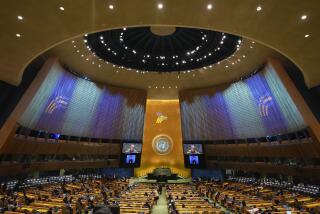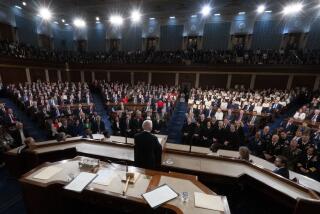Trade Pact on Slippery Slope
WASHINGTON — President Bush will pursue his top trade initiative today as he welcomes six Latin American leaders to the White House, but the trade agreement Bush seeks faces serious trouble in Congress and could be defeated by his fellow Republicans.
With showdown votes just weeks away, the Central American Free Trade Agreement still lacks majority support in the Senate and the House, with a near-solid phalanx of Democrats lined up in opposition and key Republicans in open revolt.
The battle over CAFTA, as the agreement is known, illustrates the crosscurrents that swirl through Congress whenever a major trade issue surfaces, as local political imperatives often trump party loyalty. The trade controversy also underscores the pitfalls of Bush’s strategy of relying on his slim majorities in Congress to enact a Republican agenda.
Moreover, it hints at the limits to the political capital that a newly reelected Bush had claimed only six months ago, now that his job approval ratings are declining amid rising gasoline prices and the resurgent violence in Iraq.
The Bush administration and its allies on Capitol Hill concede the uphill struggle for CAFTA, but insist they will prevail.
“We’re not there yet,” said Rep. Kevin Brady (R-Texas), who was leading the charge in the House.
The six presidents Bush is to meet with today are Enrique Bolanos of Nicaragua, Ricardo Maduro of Honduras, Abel Pacheco of Costa Rica, Oscar Berger of Guatemala, Tony Saca of El Salvador and Leonel Fernandez of the Dominican Republic.
A Bush loss on the pact would have repercussions far beyond trade with the six countries.
It could accelerate Bush’s lame-duck status and perhaps weaken him politically to the point of impairing his ability to successfully push other controversial priorities.
The White House is dealing with a number of issues -- including Social Security and immigration -- and “a defeat on any one of them would confirm what we already know: that the president doesn’t have a lot of clout right now,” said Stuart Rothenberg, an independent political analyst in Washington.
Modeled after the North American Free Trade Agreement, which liberalized trade among the United States, Mexico and Canada, CAFTA would end most tariffs and import restrictions on trade between the six nations and the United States.
The administration says the pact would create, after Mexico, the second-largest export market in Latin America for U.S. goods and services, valued at $15 billion a year. The American Farm Bureau Federation estimated that CAFTA would expand U.S. farm exports by $1.5 billion annually.
Rob Portman, the U.S. trade representative, has argued that the pact would help ease America’s trade deficit by allowing the U.S. to compete more effectively against China, especially in the clothing business. Garment factories in Central America and the Dominican Republic make up the second-biggest market for U.S. textile fabrics and yarns.
The administration further contends that CAFTA would raise living standards in Central America and the Dominican Republic, and thus promote freedom and democracy.
But critics say CAFTA does not contain sufficient protections for worker rights and training, and they warn that it would lead to job losses in the United States.
The pact’s opponents include four leaders of the New Democrat Coalition in the House, a usually pro-trade group of centrists, led by Rep. Ellen O. Tauscher (D-Walnut Creek). She called on Bush to renegotiate the “seriously flawed” pact, saying that it was “not a good deal for the people in the CAFTA countries or the people in the United States.... As ardent supporters of fair free trade, we cannot support the existing proposal.”
Gene Sperling, who was President Clinton’s economic advisor, predicted that “a substantial number of Democrats who usually support free trade” would join in that call. “They are serious about making progress on labor standards both at home and abroad,” he said.
But a top U.S. trade official who insisted on anonymity rejected such a possibility, declaring in an interview: “There will not be a renegotiation of CAFTA.”
Another CAFTA foe is Rep. Earl Blumenauer (D-Ore.), who supported all four bilateral trade agreements that came before Congress in recent years. “For me, it is clear that CAFTA does not include meaningful environmental and labor standards,” he said.
In the private sector, the sugar industry has been leading the anti-CAFTA charge, exerting its considerable influence from Louisiana and Florida to Idaho and Montana -- states where sugar is made from cane or beets and that in many cases are represented in Congress by Republicans. The industry fears CAFTA would undermine the domestic sugar industry and send U.S. jobs overseas.
“It’s very simple -- when you import subsidized foreign sugar, you export U.S. jobs,” Jack Roney, an industry analyst, told the Senate Finance Committee last month.
Already, several mountain state Republicans -- including Sen. Conrad Burns and Rep. Dennis R. Rehberg, both from Montana -- have come out strongly against CAFTA.
The textile industry, another powerful lobby in Washington, is split over the treaty, with one faction arguing that CAFTA would make the industry more competitive, especially against China, but an opposition faction warning of massive job losses. Organized labor also has been staging rallies against CAFTA.
Although the White House had expected to win CAFTA passage on the strength of Republican support, even supporters of the president and the pact conceded this week that they were short by as many as 30 votes in the House.
“There’s enough [opposition] on the Republican side that the numbers are good to defeat it if the vote’s held today,” Rep. Charles Melancon (D-La.), a fierce CAFTA foe, said Wednesday.
Brady, CAFTA’s point man in the House, said supporters hoped to schedule a vote near Memorial Day. But sources said the White House was resisting the early vote and preferred to have more time to mount a full campaign for CAFTA.
Rep. James P. Moran of Virginia, one of the few declared Democratic supporters of the pact, said he understood why the agreement was “in trouble in the short term.”
“There’s a lot of feeling out there that trade has not helped the economy and has cost jobs,” he said.
In addition, Moran said in an interview, “there’s a reluctance [among some Democrats] to do anything to help the White House and help [House Majority Leader Tom] DeLay. So some of it is clearly partisan.” But Moran also predicted that an all-out push by the president would turn things around.
“He needs to give it the attention that it needs in order to get the 218 votes” needed for passage, Moran said. “And I think it will, once the White House gets more involved.”
*
(BEGIN TEXT OF INFOBOX)
Continental divide
The controversial Central American Free Trade Agreement would tear down trade barriers between the United States and six Latin American nations. Here’s a look at the region and the current level of trade with the United States.
Volume of U.S. imports and exports in 2004 (in billions)
*--* U.S. imports U.S. exports from each country to each country Dominican Republic $4.53 $4.34 Honduras $3.64 $3.08 Costa Rica $3.33 $3.30 Guatemala $3.15 $2.55 El Salvador $2.05 $1.87 Nicaragua $0.99 $0.59
*--*
Sources: International Trade Administration
More to Read
Sign up for Essential California
The most important California stories and recommendations in your inbox every morning.
You may occasionally receive promotional content from the Los Angeles Times.










